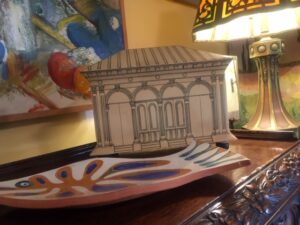 HH sent me a box with a distinctive classical Renaissance PalladianPalladian print superimposed upon it, with a unique perspective, I see a near illegible signature beginning with “F” and ending in “I.” Dare I suggest this might be a Piero Fornasetti (1913-1988)?
HH sent me a box with a distinctive classical Renaissance PalladianPalladian print superimposed upon it, with a unique perspective, I see a near illegible signature beginning with “F” and ending in “I.” Dare I suggest this might be a Piero Fornasetti (1913-1988)?
Fornasetti, a painter, designer, and industrial designer, became incredibly influential in the history of design. He created 13,000 works, decorative objects, and furniture often copies and mass produced by decree. You see, he wanted everyone to own a useable piece of art in their own homes.
Piero’s Practical Madness
His famous atelier opened in Milan in the 1950s and is now under the baton of his son Barnaba Fornasetti. Piero based his work on the “Principle of Practical MadnessPiero based his work on the “Principle of Practical Madness.” I love the sound of that.
He meant to make each piece part historically referenceable, part dreamscape, functional, and mind altering, because all good art should do the ‘mind altering’ part. Pablo Neruda called him “the magician of precious and precise magic.” This means Piero used the LINE to convey space, fantasy, and perspective with an effect on the imagination. Without using one’s imagination, it’s hard to understand Fornasetti.
Piero Fornasetti began his artistic life by learning the printing process and engraving, and his oeuvre became the printed motif on an object of function. Trained in a print shop, he opened his own “Fine Art Printshop” in the 1940s under the cloud of war. When money and materials became short in Italy he printed easy to acquire objects like books, cards, calendars, and almanacs to give as little gifts. In the war he served, but because of a glitch they didn’t not call him to fight. Instead they gave him the job (these Italians are wonderful) of painting and decorating the Sant’Ambrogio barracks. He designed for the theater at this time; sets, magazines, and posters.
Fornasetti and Ponti
Then came his liaison with Gio Ponti, and he collaborated with that master on interiors designs for home, shops, and cinemas. He, with Ponti, designed a famous piece for the 1951 Triennale, a mirror with a design to the top called “Architettura Trumeau.” Ponti went on to design the first class section of the famed ship the Andrea Doria in 1952, with the idea that one can live well in an exceedingly small space.
Once he created a design, he made MANY variations, also a departure for the “old” perception of a work of art as unique. Consider that iconic female face on a plate redone in 400 versions with not ONE original work (Theme and Variations).
Fornasetii became Post Modern before Post Modern existed. He took a beautiful but reproducible print, then played with that design on different surfaces. Which means the perspective lines changed not only the OBJECT but the DESIGN. These pieces create delightful confusing perspectives. Some people call his work magical.
Fornasetti said: “The artist puts things in order to create another world- that is second nature.” His friend the artist and inventor Bruno Munari said such pieces can only be measured by the yardstick of Fornasetti.
Rocky Terrain
In the 1960s Fornasetii found himself on rocky terrain. The world of architecture and design took a turn towards minimalism over ornamentation, function over form; not what this imaginative designer had practiced. With friends he opened a gallery for all artists, including those who painted in a more surreal and figurative style. He started painting again and created figures out of visions of fruit and other objects. In the 1980s he opened a gallery in London “Theme and Variations.” He died shortly thereafter.
In 2013 The Triennale Design Museum in Milan gave him a retrospective which sold out. Essentially, they rediscovered him, and the show travelled to the Musee des Arts Decorative in Paris and then onto Seoul. The design world saw the value of his contribution to design, and how his work influences designers still. He said, “observe the real to be able to consciously forget it and recreate it through your intellect, your imagination, and through design.”
In short, HH’s piece COULD be a work by Forasetti. But as I said, the artist was in approval of those who used his concepts as art for the people, therefore we call this “after” Fornasetti. I love the expression “The Principle of Practical Madness!” The value is $400.
Hi,
Love your work and educational benefits that result from it, your more inspirational and of value internationally than you truly realise.
Peter Taylor
Dunedin
South Island
New Zealand